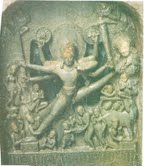Dear all,
An important and pertinent issue has been raised by Bhaju Suresh in www.nepalmandal.com (link in support also at www.karunaguthi.com) that needs to be reached to all there in Sikkim as well. I have tried to encapsulate taking just five lines from the page and attempted to put it what it means to those not familiar with our mother language. It says, “We need not have a sait ( a time auspicious - as such since the day and a festival is itself auspicious) not only for Kijapuja but also for Mohni (Dashain) to put or accept tika. Mhapuja has been a festival to all the Newars followed traditionally for ages together. Now we have accepted it as the Festival of the Newar Unity. Our Kijapuja is only on the third day (Nov 8, 2010) - two days later of Laxmi Puja (Nov 6, 2010) and a day after Mhapuja (Nov 7, 2010). There is no reason to have two minds about it”
"किजापुजा जक मखु, मोहनिया चालं कुन्हु नं झी साइत स्वयाः सिन्हः तीम्वाः । म्हपुजा धइगु सम्पूर्ण नेवाःतय्सं परम्परांनिसें हना वयाच्वंगु पर्व । आः वयाः थ्व पर्वयात नेवाःतय् एकताया पर्व धकाः नं स्वीकार यायेधुंकल । झीगु किजापुजा लक्ष्मीपुजायां कंस कुन्हु अले म्हपुजायां कन्हय् कुन्हु हे लाइ । उकी दोमन यानाच्वनेमाःगु कारण हे मदु ।"
Even for Mhapuja no sait is needed. We have to sit, like for Kijapuja, before a mandap and follow the tradition step by step that we have been doing it there too in Sikkim as well. Some years ago complimentary copies of the book Mha Puja by Bhaju Satya Mohan Joshi in Nepali and Newar have been distributed in Sikkim and Darjeeling courtesy Bhaju Indra Bhakta Shrestha of Kathmandu and it has helped us a lot to know more about the festival.
Subhay.
Yours sincerely,
for KARUNA DEVI SMARAK DHARMARTH GUTHI,
RAJIVA SHANKER SHRESTA
तिथि व झीगु नखःचखः is available here
Further, we are overwhelmed by the prompt response received from various authorities on the subject the same day and expected some more encouraging opinions, if posted on this page of our website. We invite comments to make this discussion more educative and informative as well.
Johann Wolfgang Von Goethe
Rajiva Bhaju,
Many thanks for your kind mail, purporting to clarify the tradition of celebrating Mhapuja among the Newar community.
Our tradition is based on the Hindu puranas. For example, the Vishunu Purana narrates an episode of how Vishnu banished the generous demon king Baliraja to Hell by taking the whole universe (the Sky and the Earth) in two steps, and the third step is placed on Bali's head. With that step Vishnu also banishes Bali to Hell. However, because of his renowned generosity he was allowed to celebrate three days in a year with lights and festivities. The first night of the bright fortnight of the lunar month of Karttika is also known as Bali-pratipada and the preceding night is celebrated in festivities as "self-worship" as "Sukha-ratri" the night of happiness. It was the exceptional moment, when Lord Siva conceded to play a game of cowrie with Parvati.
This episode goes back to the Vedas (where Vishnu is already eulogized as the trivikrama) , and it is elaborated and rendered in several variant versions in the Padma Purana, the Surya Purana and , above all , in the Aditya Purana. Our local Svayambhu Purana also waxes eloquently on the merits of celebrating this night.
The worship of the Self, represented by the mandala symbolism decorated with five grains, five elements and serving a samaya consisting of five potent substances is an ougrowth of tantric tradition going back to the Nishpannayogavali of Advayavajra and his lineage ca. 11th century AD.
That the festival of lights goes back at least to a millennium and a half (ca 5th century AD) is beyond doubt. Its evidence is also provided by Nepalese art. There are two identical sculptures of the Baliraja episode, one in Tilaganga, Pashupati , dated AD 464 and another in Lazimpat now preserved in the National Museum, dated 3 years later.
I am afraid the festival has nothing to do with the founding of Nepala-samvat. The Newar community didn't invent it. If Satya Mohan Joshi and his acolytes think so they are misled by little knowledge they have of Astronomy and less of culture. I hope this is not yet another sad example of the lame man leading the blind!
Official lunar calender everywhere in the world is based on mathematical calculations of the ending moment of a tithi, the duration of a lunar "day".
Its span varies from day to day. It does not coincide, like civil day, with sunrise to sunrise. Tithis may last more or less than a civil day, or they may be "lost" in adjustment with the solar calendar. Please go to http://www.calender converter. There are hundreds of software to check when does Karttika shukla pratipada begin and Aswina amavashya end this year or any year.
Do we follow the beginning , the duration, or the ending moment of a tithi ? Doesn't tithi matter at all in a lunar calendar which is the backbone of all our festivals, rites, and rituals?
Opinions among our Hindu/Buddhist ritual specialists depend upon the "school" of the pundit----whether he follows the Maithili, the Dravida, the Kaynakubja or the Gaudiya school.That in turn depends upon where his forefathers were from --the south, the north, the east and the west of the Aryavarta!
The textual sources such as the Nirnaya Sindhu are cited by them as "the Shastra"---as if there is only one. But the bad news is that there are more than 30 such divergent "authorities" on when to celebrate a festival or perform a ritual depending at times upon whether it is inauspicious or an auspicious one.
"Fools rush in where angels fear to tread,"wrote Alexander Pope.Often I fail to understand when our "leaders" become so categorical on what every member of the community must do.
Sincerely,
Kamal P. Malla
California
-----
Oct 4, 2010
Dear Bhaju Kamalju,
Jwajalappa!
Thank you for your learned opinion in prompt response to what I tried to put across my fellow Newar brethren back home in Sikkim this morning.
I have received a few other comments as well on the issue that I would like share with you all posted on www.karunaguthi.com for more. I shall be grateful if you could kindly give your further opinion and advise us on the issue and whether we should follow or leave it up to individual themselves to decide.
I read just a while ago :
“To think creatively, we must be able to look afresh at what we normally take for granted.” - Johann Wolfgang Von Goethe
Thank you once again.
Yours sincerely,
RAJIVA
-----
Rajiva Bhaju,
Attached with this mail is a copy of the sculpture I mentioned in my mail. On the right side is Baliraja, the demon king, who was permitted a three-day respite in Hell. That is what we celebrate as svanhu-tithi in Nepal.! This is where our mhapuja comes from!
At the bottom, there is also the portrait of Vaman avatar assumed by Vishnu to trick the demon king to agree to give a gift to .the dwarf beggar who asks for just enough land to take three steps.
Art historians believe that this is a unique masterpiece, capturing a dramatic moment as well as graphic details in early art.
I hope you will like it.
Sincerely,
Kamal P. Malla
Just a quick response Rajiv ju Thanks for circulation
We should keep our view separate from Celebration of Nepal Sambat and Mhapooja. They are two different subjects some people have tried to mixed these two event in to one and call Nepal Sambat as Newar New year to devalue the national importance in Nepal. Even in my life we used to close down the fiscal year on day of Laxmi Pujaa as and starts new accounting form the day after Kijapooja as the final day of yama panchaka. Kija pooja has another significant value this is not Daai pooja but in KPG many Newars do Daai pujaa too as diluted festival with influence of other culture such as Rakshya Bandhan tradition that allows to respect siblings. Mohani Tika and Mhapujaa, are as auspicious as Bhin Ekadasi, Guru punhi, Shri Panchami etc.etc,
Can you create a group email with members of all your contacts in Sikkim who need knowledge on Newah awareness ? So we can interact frequently to exchange the ideas among Sikkim Newars.
By the way, Did you get my package with Matina ?
Daya
-----
My remarks on this issue may be of your interest:
नेवाःतय् साइत स्वयाः किजापुजा यायेम्वाः । साइत स्वयाः किजापुजा यायेगु चलन खय्ब्रम्हूया 'भाइटीका' पाखें लिपा वया जक सयेका काःगु खः। उमि किजायात सिन्हः तिकल कि ज्या क्वचाः । झी किजा वा दाजुयात सिन्हः जक तिकां मगाः पूरा मन्दः च्वयाः पुजा यायेमाः । उकिं झीसं भाइटीका (किजायात सिन्ह तिकेगु) जक मधासें "किजापुजा" धाइ । 'भाइटीका' याइपिंत साइत मालेफु तर 'किजापुजा' याइपिंत मालीमखु । किजापुजाया सन्दर्भय् झीके "साइत"या च्यूता: यायेउ प्रवृत्ति अप्वया वन । संचार माध्यमय् "भाइटिकाको साइत"या प्रचार यक्व जुजुं वना झीसं झीगु "किजापुजा" चलनया मर्म हे मथुया वनाच्वन । खँय बर्मुतयेउ चलन व झीगु चलनय् छु पा: धयागु मर्म थुइकेत झीगु व इमिगु पुजा यायेगु तरिका न्ह्यथनेगु धैगु बदख्वाइँ मखु । बदख्वाइँ जुइत ला - "इमिगु बाँमला झीगु बाँला " धका धायेमाल । सुरेश मानन्धरजुया लेखय् अथे "बदख्वाइं" जुइक च्वयात:उ ला मखना । तर पाना च्वंगु खँ थथे थथे पा: धका मधायेकं थ्व खँ गय याना स्पष्ट जुइ ? साइत हे स्वयेम्वा:थाय् साइत स्वयेगु भ्वासिपह पिहाँ वसेंलिं व प्रवृत्ति गनं वल धका विचा: सहलह यायेगु अनुचित मजू । साइत स्वया "भाइटिका" याइपिं खँयतसें साइत स्वसा जि हे जिल, झी किजापुजा यायेउ जूसा "साइत" धका हाला च्वनेम्वा:।
म्ह पुजाया सन्दर्भय् दँयदसं तिथि गोलमाल जुया वसेलिं झीसं थ्व तिथिया मेकानिज्म छु ख: धका: च्यूता:कायेगु स्वभाविक हे ख:। तिथि तुत: जुल धका धाइगु खँ न मखु खनीसा । तिथि ला गबलें नं तुत: जुइमखु, खालि तिथि व सुर्योदय-सुर्यास्तया दथ्विइ "सिन्क्रोनाइज" मजुइगु जक जुयाच्वन खनीसा । शास्त्रया हे खँ ल्हायेगु ख:सा शास्त्रं धा:थे हिसाबयाना तिथि पिकायबलय न्ह्याम्हेसिनं हिसाब यासा व हे तिथि वयेमाउ मखुला ? तर मव: । अथे मवइयु जुया हे पञ्चांङग निर्णायक समिति च्वना व हिसाव ब्यावहारीक जुइक मिलेयाये मा:उ ख:। अथे जूसा थ्व जाग्वारा समितिं छाय तिथि हे बेपत्ता जुइक पात्र पिथनिगु? न्हापा नेवा: जोतिषत व समितिइ दुबलय् गबलें नं अथे गोलमाल मजू । आ बर्मू जोतिषत दया व: लिसे न्ह्याबलें गोलमाल गोलमाल ।
आ: थ्व स्वयेबलय् नेवा: तयेगु बिस्कं हे क्यालेण्डर पिकाये मा: थेँ च्वनावल
Roshan Shrestha



 RSS Feed
RSS Feed
